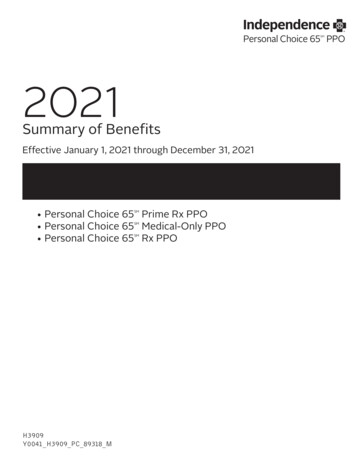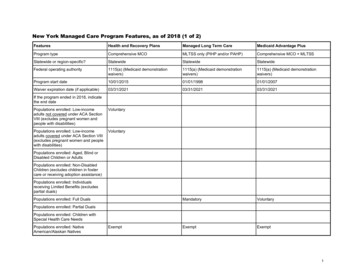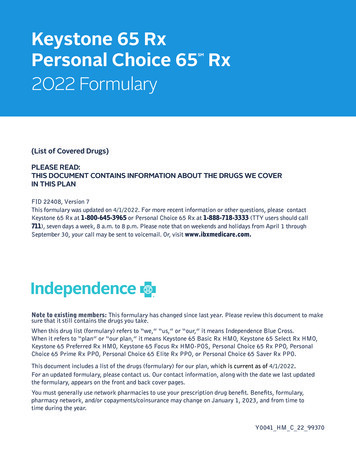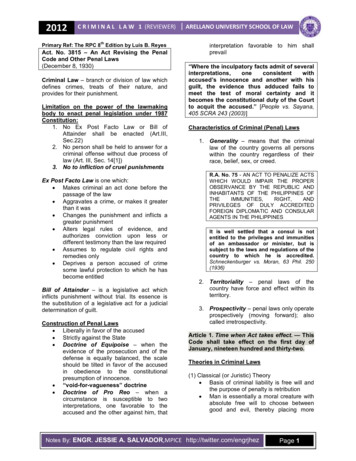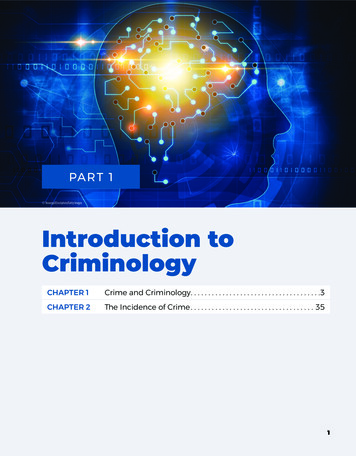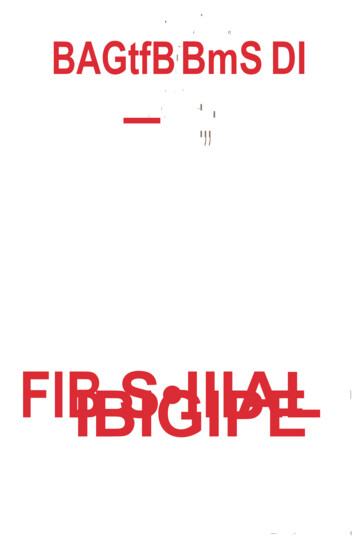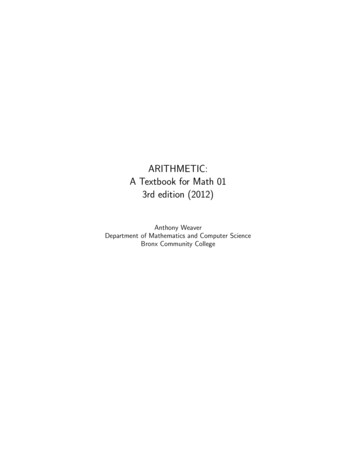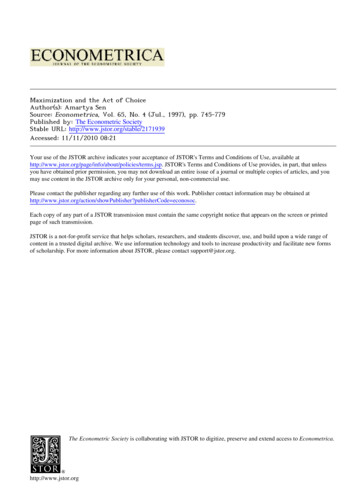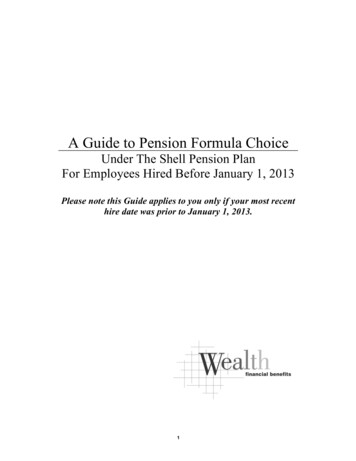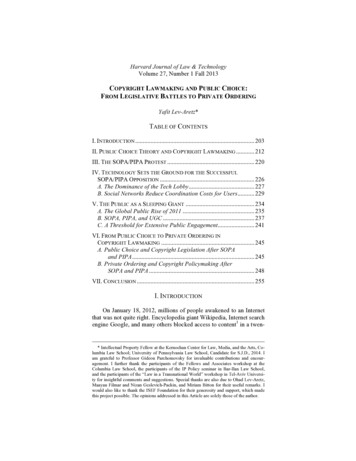
Transcription
Harvard Journal of Law & TechnologyVolume 27, Number 1 Fall 2013COPYRIGHT LAWMAKING AND PUBLIC CHOICE:FROM LEGISLATIVE BATTLES TO PRIVATE ORDERINGYafit Lev-Aretz*TABLE OF CONTENTSI. INTRODUCTION . 203!II. PUBLIC CHOICE THEORY AND COPYRIGHT LAWMAKING . 212!III. THE SOPA/PIPA PROTEST . 220!IV. TECHNOLOGY SETS THE GROUND FOR THE SUCCESSFULSOPA/PIPA OPPOSITION . 226!A. The Dominance of the Tech Lobby . 227!B. Social Networks Reduce Coordination Costs for Users. 229!V. THE PUBLIC AS A SLEEPING GIANT . 234!A. The Global Public Rise of 2011 . 235!B. SOPA, PIPA, and UGC . 237!C. A Threshold for Extensive Public Engagement. 241!VI. FROM PUBLIC CHOICE TO PRIVATE ORDERING INCOPYRIGHT LAWMAKING . 245!A. Public Choice and Copyright Legislation After SOPAand PIPA . 245!B. Private Ordering and Copyright Policymaking AfterSOPA and PIPA . 248!VII. CONCLUSION . 255!I. INTRODUCTIONOn January 18, 2012, millions of people awakened to an Internetthat was not quite right. Encyclopedia giant Wikipedia, Internet searchengine Google, and many others blocked access to content1 in a twen-* Intellectual Property Fellow at the Kernochan Center for Law, Media, and the Arts, Columbia Law School; University of Pennsylvania Law School, Candidate for S.J.D., 2014. Iam grateful to Professor Gideon Parchomovsky for invaluable contributions and encouragement. I further thank the participants of the Fellows and Associates workshop at theColumbia Law School, the participants of the IP Policy seminar in Bar-Ilan Law School,and the participants of the “Law in a Transnational World” workshop in Tel-Aviv University for insightful comments and suggestions. Special thanks are also due to Ohad Lev-Aretz,Maayan Filmar and Nizan Geslevich-Packin, and Miriam Bitton for their useful remarks. Iwould also like to thank the ISEF Foundation for their generosity and support, which madethis project possible. The opinions addressed in this Article are solely those of the author.
204Harvard Journal of Law & Technology[Vol. 27ty-four-hour strike to symbolize their opposition to two anti-piracybills: The Stop Online Piracy Act (“SOPA”)2 and its Senate companion, the Preventing Real Online Threats to Economic Creativity andTheft of Intellectual Property Act (“PIPA”).3 The two Bills wouldexpand the power of U.S. law enforcement to combat online trafficking in copyrighted content and counterfeit goods by enabling courtorders to prevent advertisers and payment facilities from conductingbusiness with infringing websites, search engines from linking tothem, and Internet Service Providers (“ISPs”) from offering access tothe sites.4Over one hundred thousand websites5 took part in the strike, during which some were effectively closed, while others featured information about the Bills and directed users to action centers to comcommunicate their worries to Congress.6 Users zealously respondedand fulminated against the Bills through posts on social networks,online petitions, and e-mails and phone calls to Congress.7 The protestwas unanimously hailed as successful, as the stated positions bymembers of Congress on SOPA and PIPA shifted overnight from 80for and 31 against to 55 for and 205 against.8 According to formerHouse Judiciary Committee Chairman Lamar Smith, the House ofRepresentatives “postpone[d] consideration of the legislation untilthere [was] wider agreement on a solution.”9 Senate Majority LeaderHarry Reid announced that the procedural vote on PIPA, which had1. See Ned Potter, SOPA Blackout: Wikipedia, Google, Wired Protest ‘Internet Censorship,’ ABC NEWS (Jan. 18, 2012, 11:00 AM), inst-internetcensorship/.2. Stop Online Piracy Act, H.R. 3261, 112th Cong. (2011).3. Preventing Real Online Threats to Economic Creativity and Theft of Intellectual Property Act of 2011, S. 968, 112th Cong. (2011) (also known as the Protect IP Act).4. CONG. RESEARCH SERV., BILL SUMMARY & STATUS S. 968, 112th Cong. y/z?d112:SN00968:@@@D&summ2 m&; CONG. RESEARCH SERV., BILL SUMMARY & STATUS H.R. 3261, 112th Cong. query/z?d112:HR03261:@@@D&summ2 m&.5. The January 18th Blackout / Strike in Numbers and Screenshots, FIGHT FOR THEFUTURE, http://www.sopastrike.com/numbers/ (last visited Dec. 20, 2013).6. Potter, supra note 1.7. FIGHT FOR THE FUTURE, supra note 5.8. See Dan Nguyen, SOPA Opera Update: Opposition Surges, PRO PUBLICA (Jan. 19,2012, 12:39 PM), date (statingSOPA/PIPA had eighty supporters and thirty-one opponents on January 18); Dan Nguyen,SOPA Opera: Where Do Your Members of Congress Stand on SOPA and PIPA?, PROPUBLICA (Jan. 20, 2012), http://projects.propublica.org/sopa/ (stating SOPA/PIPA had 55supporters and 205 opponents and “Leaning No” as of January 20th).9. Jonathan Weisman, After an Online Firestorm, Congress Shelves Antipiracy Bills,N.Y. TIMES, Jan. 20, 2012, available at e-postpones-piracy-vote.html? r 1.
No. 1]Copyright Lawmaking and Public Choice205been scheduled for January 24th, would be postponed “[i]n light ofrecent events.”10The ability to organize a large crowd with diffuse interests intoeffective political action — as seen in the SOPA/PIPA protest —challenges a broad array of copyright scholars using public choicetheory to demonstrate the disproportionate influence copyright holders, especially the entertainment industries, have had on copyrightlawmaking.11 Based on the assumption that decisions in public entitiesare made by individuals attempting to advance their rational interests,public choice theory looks at administrative decisions as the productof pressure from interest groups.12 According to public choice models,the lawmaking process involves organized interest groups who compete to implement their agenda, while the outcome is dictated by relative group strength — the group with the greatest political capital islikely to wield superior influence on the process.13 Consequentially,the market for legislation systematically produces too few laws thatare conducive to the overall benefit of society (i.e., “public goods”),while systematically delivering too many laws that allocate resourcesto an interested group (i.e., “rent-seeking” laws).14By applying public choice analysis to copyright lawmaking, aprominent body of copyright scholarship has argued that for virtuallytwenty years the content industries have used their political power toextend the scope, reach, and enforcement of copyright at the expenseof the general public.15 Under this line of commentary, copyrightowners are a well-organized group with resources and clearly definedinterests, while the public consists of decentralized groups sufferingfrom collective action problems.16 The practical consequence of thedisparateness of the public is a systematic bias within the legislativeprocess, where the public is unable to effectively advocate for itself,while the interests of copyright owners and the content industries are10. Harry Reid, Twitter Feed, TWITTER (Jan. 20, 2012, 6:27 AM), 4878080 (“In light of recent events, I have decided to postpone Tuesday’s vote on the PROTECT IP Act #PIPA.”).11. See, e.g., LAWRENCE LESSIG, THE FUTURE OF IDEAS: THE FATE OF THE COMMONS INA CONNECTED WORLD 85–97 (2001); Jessica Litman, Copyright Legislation and Technological Change, 68 ORE. L. REV. 275, 277 (1989) (suggesting that “the nature of the legislative process we have relied on for copyright revision is largely to blame for those laws’deficiencies”); infra Part II.12. MAXWELL L. STEARNS & TODD J. ZYWICKI, PUBLIC CHOICE CONCEPTS ANDAPPLICATIONS IN LAW 7–10 (2009).13. See Gary S. Becker, A Theory of Competition Among Pressure Groups for PoliticalInfluence, 98 Q.J. ECON. 371, 380 (1983).14. William N. Eskridge, Jr., Politics Without Romance: Implications of Public ChoiceTheory for Statutory Interpretation, 74 VA. L. REV. 275, 285 (1988).15. Yochai Benkler, Seven Lessons from SOPA/PIPA/Megaupload and Four Proposalson Where We Go from Here, TECH PRESIDENT (Jan. 25, 2012), here.16. See infra Part II.
206Harvard Journal of Law & Technology[Vol. 27broadly met.17 Professor Jessica Litman, who is most closely identified with this argument, has demonstrated through a typical publicchoice analysis how commercial interests shaped the 1976 CopyrightAct and the Digital Millennium Copyright Act (“DMCA”).18 According to Litman, “our copyright laws have been written not by Congress,not by Congressional staffers, not by the copyright office or by anypublic servant in the executive branch, but by copyright lobbyists.”19Professor Lawrence Lessig also pointed to the influence of powerfulcopyright owners in the enactment of the Sonny Bono CopyrightTerm Extension Act,20 which extended copyright protection for allworks by an additional twenty years.21While the public choice theory argument has not been met withunanimous agreement,22 the claim that the copyright industry has hadan excessively forceful position in drafting copyright legislation couldhardly be confuted — that is, until recently. The SOPA/PIPA protesthighlighted what many view as a shift toward a new political calculusin copyright lawmaking.23Two relatively recent developments have paved the way for theoverwhelming success of the SOPA/PIPA backlash: (1) the tech lobbybecame stronger and successfully countered the traditionally dominantentertainment lobby in Washington, and (2) social networks loweredcoordination costs for users wishing to mobilize into political action.The introduction of the Internet and copying technologies has redefined the target of copyright legislation, adding technology providersand end-users to the circle of affected parties.24 As a result, an additional sector entered copyright politics: the tech industry. As yearspassed, the tech sector has turned into a highly influential actor and17. See Litman, supra note 11, at 281 (“The 1976 Act solved the problem of accommodating future technology by reserving to the copyright owner control over uses of copyrighted works made possible by that technology. Broad, expansive rights were balanced by narnarrow, stingy exceptions.”); JESSICA LITMAN, DIGITAL COPYRIGHT 74 (2001) [hereinafterLITMAN, DIGITAL COPYRIGHT].18. See Copyright Act of 1976, Pub. L. No. 94-553, 90 Stat. 2541 (1976) (codified asamended at 17 U.S.C. §§ 101–810 (2012)); Digital Millennium Copyright Act, Pub. L. No.105-304, 112 Stat. 2860 (1998) (codified as amended in scattered sections of 17 U.S.C. and28 U.S.C. (2012)); LITMAN, DIGITAL COPYRIGHT, supra note 17, at 74, 128–45.19. Jessica Litman, War Stories, 20 CARDOZO ARTS & ENT. L.J. 337, 350 (2002).20. Sonny Bono Copyright Term Extension Act, Pub. L. No. 105-298, 112 Stat. 2827(1998) (codified as amended at 17 U.S.C. §§ 108, 203, 301–304 (2012)).21. LAWRENCE LESSIG, FREE CULTURE 134 (2004).22. This body of scholarship has been criticized for its sweeping design of the publicchoice argument by other prominent scholars, like Robert Merges, who attributed the expansion of copyright to efficiency-promoting modifications. See Timothy Wu, Copyright’sCommunications Policy, 103 MICH. L. REV. 278, 291 (2004).23. Benkler, supra note 15 (noting the “political calculus” was changed following theSOPA/PIPA protest).24. See Daniel Gervais, The Tangled Web of UGC: Making Copyright Sense of UserGenerated Content, 11 VAND. J. ENT. & TECH. L. 841, 846–48, 860 (2009).
No. 1]Copyright Lawmaking and Public Choice207increased its lobbying efforts in Washington.25 Google, for example,went from spending 5.2 million in 2010 to 18.2 million in 2012,26and Facebook nearly tripled its lobbying expenses between 2011 and2012.27 Some viewed the SOPA/PIPA battle as the opening test of thepolitical strength of the tech and Internet industries, which, for thefirst time, took an uncompromising stand against some of the uppermost lobbying interests in Washington, including the United StatesChamber of Commerce and the Motion Picture Association of America.28 Federal disclosure records show that a total of 115 companiesand organizations had lobbyists working on both sides of the antipiracy Bills.29Still, the overnight transformation in lawmakers’ position cannotbe attributed to corporate lobbying alone.30 The protest against theBills, which successfully swayed lawmakers to oppose SOPA andPIPA, also originated as a grassroots movement in social media, blogging websites, e-mail chains, and numerous message and discussionboards.31 While past copyright legislative efforts did not capture agreat deal of public attention, as more people use technological meansto communicate through online networks, individual users have be-25. According to a report by the Center for Responsive Politics, the computer and Internet industries spent more than 133 million on lobbying in 2012. Compare Lobbying, Computers/Internet Industry Profile, 2012, CTR. FOR RESPONSIVE POLITICS (July 29, .php?id B12&year 2012 [hereinafter Lobbying, Computers/Internet, 2012], with Lobbying, TV/Movies/Music Industry Profile, 2012,CTR. FOR RESPONSIVE POLITICS (July 29, 2013), d B02&year 2012 [hereinafter Lobbying, TV/Movies/Music, 2012](reporting that the total lobbying by TV/Movies/Music was more than 117 million).26. Compare Lobbying by Google Inc. in 2010, CTR. FOR RESPONSIVE m.php?id D000022008&year 2010 (last visitedDec. 20, 2013) [hereinafter Lobbying by Google in 2010], with Lobbying by Google Inc. crets.org/lobby/clientsum.php?id D000022008&year 2012 (last visited Dec. 20, 2013) [hereinafter Lobbying by Google in 2012].27. Compare Lobbying by Facebook Inc. in 2011, CTR. FOR RESPONSIVE m.php?id D000033563&year 2011 (last visitedDec. 20, 2013) [hereinafter Lobbying by Facebook in 2011] (reporting Facebook spent 1,350,000 on lobbying in 2011), with Lobbying by Facebook Inc. in 2012, CTR. FORRESPONSIVE POLITICS, http://www.opensecrets.org/lobby/clientsum.php?id D000033563&year 2012 (last visited Dec. 20, 2013) [hereinafter Lobbying by Facebook in 2012] (reporting Facebook spent 3,850,000 on lobbying in 2012).28. See Jenna Wortham, A Political Coming of Age for the Tech Industry, N.Y. TIMES(Jan. 17, 2012), ide-protest-overtwo-antipiracy-bills.html.29. Id.30. For a similar view, see Somini Sengupta, Big Victory on Internet Buoys Lobby, N.Y.TIMES (Jan. 26, 2012), . See Jenna Wortham, Public Outcry over Antipiracy Bills Began as Grass-RootsGrumbling, N.Y. TIMES (Jan. 19, 2012), s-grumbling.html? r 1&pagewanted all.
208Harvard Journal of Law & Technology[Vol. 27come further involved in copyright debates.32 Technological advancements have also provided the means through which users caneffectively campaign for their interests. In particular, social and participatory media33 have decreased transaction costs for collective action. With its global reach, social media, like Wikipedia andFacebook, has stimulated the diffusion of information and reducedinformation costs, such as those associated with informing the publicabout legislative bills and their ramifications.34 Social media has alsosignificantly reduced organizational costs for social movement actors,allowing them to mobilize and collaborate beyond time and spaceconstraints.35 Thanks to social media, Internet users could overcomecollective action problems and influence lawmakers’ decisions duringthe SOPA/PIPA revolt.In the days following the SOPA strike, Internet activists rejoicedwith new hope for a better, more balanced, copyright reality. With thepublic now holding the power to sway lawmakers, theoretically thelatter would be more prudent when considering legislation that theformer regards as harmful to the open and participatory culture of theInternet.36 This Article argues, however, that while social networkshave empowered individuals to become more active in the politicalarena, the success of the SOPA/PIPA revolt does not herald the end ofthe issues in copyright lawmaking identified by public choice theory.Specific characteristics of the SOPA/PIPA protest indicate that thepublic should be viewed as a “sleeping giant” who may or may notawaken to actively participate in copyright legislative debates. First,the SOPA/PIPA events were part of a wave of uprisings that stormedaround the world at that time.37 Personal and inspirational links to theOccupy movement in the United States and to the Arab Spring in Africa and the Middle East testify to the place of the SOPA/PIPA eventsin the global trend.3832. See Ben Depoorter, Technology and Uncertainty: The Shaping Effect on CopyrightLaw, 157 U. PA. L. REV. 1831, 1837 (2009).33. Andreas Kaplan and Michael Haenlein defined social media as “a group of Internetbased applications that build on the ideological and technological foundations of Web 2.0,and that allow the creation and exchange of User Generated Content.” Andreas M. Kaplan& Michael Haenlein, Users of the World, Unite! The Challenges and Opportunities of Social Media, 53 BUS. HORIZONS 59, 61 (2010), quoted in Sarah Joseph, Social Media, Political Change, and Human Rights, 35 B.C. INT’L & COMP. L. REV. 145, 146 (2012).34. See Christopher M. Mascaro & Sean P. Goggins, Brewing up Citizen Engagement:The Coffee Party on Facebook, in COMMUNITIES & TECHNOLOGIES, PROCEEDINGS OF THE5TH INTERNATIONAL CONFERENCE ON COMMUNITIES AND TECHNOLOGIES 11, 11 (2011).35. Jeroen Van Laer & Peter Van Aelst, Internet and Social Movement Action Repertoires: Opportunities and Limitations, 13 INFO. COMM. & SOC’Y 1146, 1151 (2010).36. Leslie Harris, PIPA / SOPA and the Online Tsunami: A First Draft of the Future,ABC NEWS (Feb. 2, 2012), tsunamidraft-future/story?id 15500925.37. See infra V.A.38. See infra text accompanying note 258.
No. 1]Copyright Lawmaking and Public Choice209Second, SOPA and PIPA purportedly threatened webhosts of user-generated content (“UGC”), such as Facebook and YouTube.39 Byso doing, SOPA and PIPA called into the controversy many who areapathetic to politics but who could not imagine being deprived of theirright to social sharing.40 The popularity of UGC, in this sense, playeda major role not only in lowering collective action costs, but also incondensing the interests of users during the SOPA/PIPA campaign.With the understanding that the anti-piracy Bills jeopardized users’rights to post pictures of their cute cats41 came the assurance that nogreat wall is greater than one’s Facebook wall. The potential harm toUGC networks also occasioned a vigorous alliance, which may notstand in the future, between UGC platforms and their users. UGCplatforms, whose existence purportedly would have been at risk hadthe Bills become law, had ample incentives to fight SOPA and PIPA.As the platforms’ loyal customers, users were also motivated to protect UGC networks in the face of the risk brought about by the Bills.Most importantly, UGC platforms functioned as the main informationsource and the most effective organizational tool for users to fight theanti-piracy Bills — a fact that caused many supporters of the Bills toaccuse UGC webhosts of misleading the public and misusing theirpower.42Third, the SOPA/PIPA opposition successfully passed the highthreshold for garnering extensive public engagement. While isolatingthe factors that brought about such extensive participation is beyondthe scope of this study, this Article argues that the volume of the protest could not replicate itself for every legislative initiative that potentially threatens users’ interests. The indifference of the public in theenactment process of current legislative proposals, some of which aresaid to make SOPA look “like the equivalent of a bad hair day,”39. While shutting down mainstream and established websites has always been considered highly unlikely, under some of the drafts the language of the bills could have beeninterpreted widely to include such course. See Bill Keller, Op-Ed., Steal This Column, 02/06/opinion/steal-thiscolumn.html?pagewanted all. (“Interpreted in the most draconian way, it might have criminalized innocent sites and messed with the secure plumbing of the Internet itself.”). But seeCary H. Sherman, Op-Ed., What Wikipedia Won’t Tell You, N.Y. TIMES (Feb. 7, at-wikipedia-wont-tell-you.html.40. See Ethan Zuckerman, The Cute Cat Theory Talk at ETech, ETHAN ZUCKERMAN(Mar. 8, 2008), cute-cat-theory-talkat-etech/ (“Cute cats are collateral damage when governments block sites. And even thosewho could care less about presidential shenanigans are made aware that their governmentfears online speech so much that they’re willing to censor the millions of banal videos . . . toblock a few political ones.”); Noam Cohen, As Blogs are Censored, It’s Kittens to the Rescue, N.Y. TIMES (June 21, 2009), net/22link.html? r 2.41. The cute cat theory of Internet censorship was presented in 2008 by Ethan Zuckerman, the director of the MIT Center for Civic Media. Zuckerman, supra note 40.42. See, e.g., Sherman, supra note 39.
210Harvard Journal of Law & Technology[Vol. 27strongly supports this view.43 Furthermore, the threshold of publicparticipation necessary to effectively promote a legislative reform ishigher than that necessary to prevent legislation’s enactment. Even ifall harmful copyright bills are successfully halted by the public, untilnew legislation changes current law, the present state will preserve thenegotiated agreements of industry players from 1976.44The Article then continues to revisit the public choice argumentin the post-SOPA/PIPA political reality and submits that while thethreat of waking the sleeping giant is expected to impact legislativedecisions in the near future, as time passes, that effect will not be sufficient to counteract lobbying efforts by powerful industry players.Furthermore, even if the sleeping giant can arise more frequently, thegrowing tendency of dominant industry players to explore nonlegislative venues to restructure copyright law through private ordering essentially constructs a large-scale copyright regime away fromthe public eye. With the public rarely cognizant of those arrangements, its ability to review them and to oppose them is far more limited. Many commentators have already recognized that rights holdersprefer contractual arrangements and technological protectionmeasures to governmental policing.45 Private ordering in copyrighthas manifested itself in three classes of interplays: (1) the userindustry relationship (e.g., digital locks on software and end-user license agreements), (2) the inter-industry relationship (e.g., collectiverights management organizations and other joint ventures),46 and (3)the cross-industry relationship (e.g., business partnerships betweenrights holders and broadband providers).47 While the deference to private ordering in user-industry and inter-industry settings has beenwidely tackled in legal commentary, private ordering in the crossindustry context has yet to be studied in detail. This form of privateenforcement, however, has significant consequences for users, as itoften directly affects their actions and legal statuses without them being fully aware of the governing arrangement’s details.43. Patrick S. Ryan, The ITU and the Internet’s Titanic Moment, 2012 STAN. TECH. L.REV. 8, ¶ 2.44. See LITMAN, DIGITAL COPYRIGHT, supra note 17, at 54–69 (discussing the negotiations leading to the 1976 Act).45. See Julie E. Cohen, Lochner in Cyberspace: The New Economic Orthodoxy of“Rights Management,” 97 MICH. L. REV. 462, 491 (1998).46. Robert Merges argues that repeat players in high-transaction-cost industries use private ordering in the form of collective rights organizations to effectively substitute theirproperty rights for liability rules. Robert P. Merges, Contracting into Liability Rules: Intellectual Property Rights and Collective Rights Organizations, 84 CALIF. L. REV. 1293(1996); see also Jonathan A. Mukai, Joint Ventures and the Online Distribution of DigitalContent, 20 BERKELEY TECH. L.J. 781 (2005) (discussing additional examples of joint ventures formed to influence the online distribution of content).47. See, e.g., Annemarie Bridy, Graduated Response and the Turn to Private Ordering inOnline Copyright Enforcement, 89 OR. L. REV. 81, 82 (2010).
No. 1]Copyright Lawmaking and Public Choice211Like other forms of private ordering in copyright, deference tocross-industry partnerships was prompted by the spread of digital media and broadband technology.48 Rights holders first attempted tofight technological reform through massive litigation, but when thatstrategy failed to provide satisfactory results, rights holders startedengaging in private collaborations with Internet intermediaries.49 Thefailure of the anti-piracy Bills may have motivated a similar reaction,as executives in the entertainment industry stated that legislation is nolonger an appealing route.50 The turn to cross-industry partnerships inthis context makes perfect sense for corporate players; it saves lobbying costs, implements quicker policy adaptations to new technologies,and economizes on potential litigation expenses. Cross-industry partnerships can also offer new business opportunities to dominant players, which could not have been carried out independently.51 Thedemand for formal rules as provided by the legislature, as well as litigation battles, are unlikely to be completely discontinued.52 Althoughprivate ordering produces an effect similar to public lawmaking whileavoiding many of the inefficiencies the latter entails, when industryplayers resort to private ordering, significant copyright practices arecarried out with no public involvement, review or opposition.The remainder of the Article unfolds in five parts. Part II discusses public choice theory and its historic bearing on the copyright lawmaking process. Part III describes the SOPA/PIPA protest from itsinception until the indefinite shelving of the Bills. Part IV analyzesthe two developments that opened the door for the successful opposition to the anti-piracy Bills: the growing dominance of the tech lobbyand social networks’ ability to reduce collective coordination costs forusers. Part V argues against the impression of a new political order incopyright lawmaking by singling out three unique attributes of the48. See Margaret Chon, Sticky Knowledge and Copyright, 2011 WIS. L. REV. 177, 202–03.49. Bridy, supra note 47, at 83; see also Yafit Lev-Aretz, Second Level Agreements, 45AKRON L. REV. 137, 166 (2012) (discussing how copyright holders have chosen to collaborate with UGC platforms); Pamela Samuelson, Copyright and Freedom of Expression inHistorical Perspective, 10 J. INTELL. PROP. L. 319, 335–36 (2003) (The motion pictureindustry also partnered with the consumer electronics industry “to agree to install anaccess-, use-, and copy-control technology, the Content Scramble System (CSS), in all DVDplayers.” Because of this inter-industry negotiation, “the motion picture industry did notneed to ask Congress to require CSS to be installed in every DVD player. It simply made aprivate agreement with the consumer electronics industry to achieve this goal.”).50. Amy Chozick, Tech and Media Elite Are Likely To Debate Piracy, N.Y. TIMES (July9, 2012), l? r 3&ref business&pagewanted all.51. Lev-Aretz, supra note 49, at 166–68.52. Regardless of the newly posed challenges, public lawmaking would remain a practical alternative for both industries. Jonathan Macey found that strong demand for legal rulescan arise “even where the norms generated by private ordering are producing enviable results.” Jonathan R. Macey, Public and Private Ordering and the Production of Legitimateand Illegitimate Legal Rules, 82 CORNELL L. REV. 1123, 1136 (1997).
212Harvard Journal of Law & Technology[Vol. 27SOPA/PIPA episode and describing the public as a sleeping giant notfrequently awakened. Part VI further demonstrates that, even if thepublic successfully overcomes public choice barriers and commonlydefends its interests in the legislative process, deference to nonlegislative alternatives through business partnerships among dominantplayers could keep major copyright policymaking away from the publ
dating future technology by reserving to the copyright owner control over uses of copyright-ed works made possible by that technology. Broad, expansive rights were balanced by nar-narrow, stingy exceptions."); JESSICA LITMAN, DIGITAL COPYRIGHT 74 (2001) [hereinafter LITMAN, DIGITAL COPYRIGHT]. 18.
